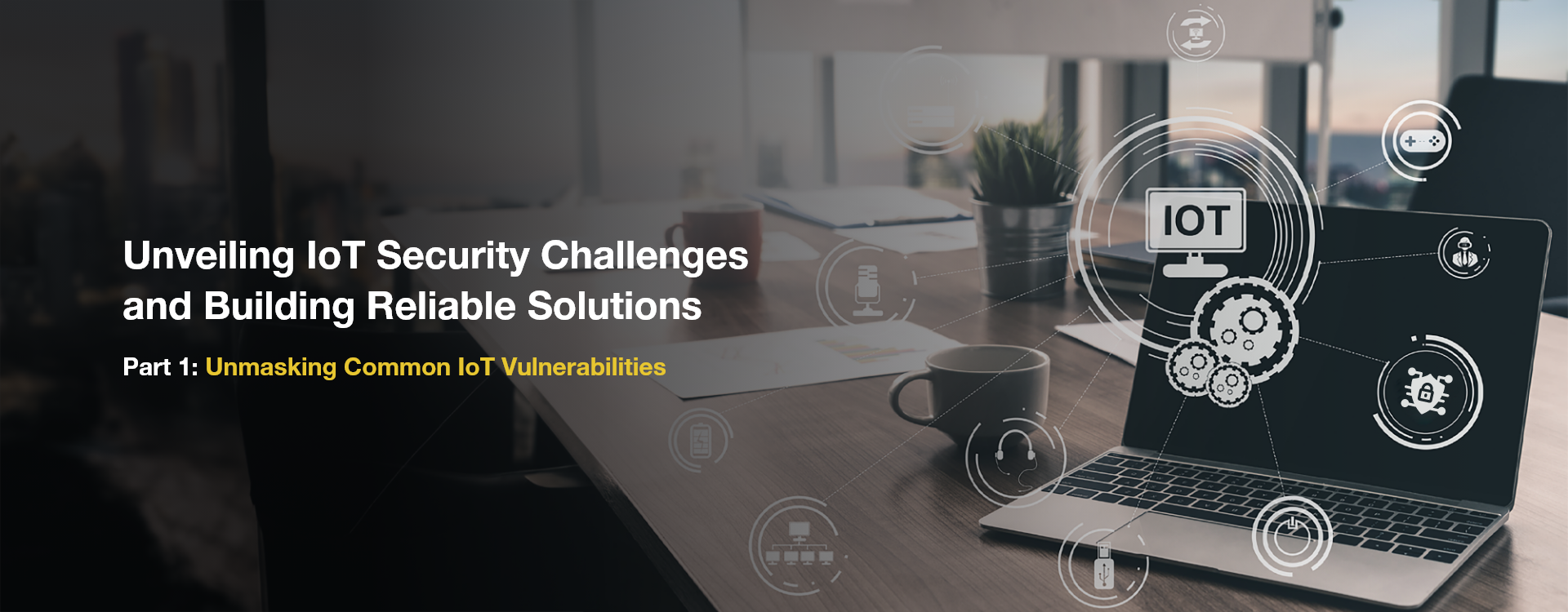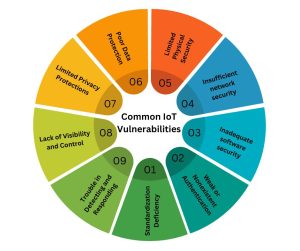

The Internet of Things (IoT) is basically a network of various physical objects which communicate with each other over the internet. It is estimated that by 2025, we will have around 75 billion connected devices, an increase of almost three times the number we had in 2019.

Thus, it is necessary to ensure the safety of IoT by strengthening components, monitoring devices, updating firmware, applying access control, responding to threats, and patching vulnerabilities.
Unfortunately, a report by Unit 42 has highlighted the declining security of IoT devices, meaning organizations are now exposed to new malware and older attack methods. As a result, a proactive and adaptive security solution must be implemented to protect ourselves from any potential risks.
Common IoT Vulnerabilities

- Standardization Deficiency: One of the most critical security difficulties in IoT is the absence of standardization. With so many different gadgets, protocols, and platforms, it can be difficult to guarantee compatibility and interoperability between them, creating openings that could be used by attackers.
- Weak or Nonexistent Authentication: Another important challenge that IoT faces is weak or nonexistent authentication. Many IoT devices are built with minimal security, making them susceptible to attacks.
- Inadequate software security: is a common issue for IoT devices, as they typically operate on embedded systems with constrained resources. Securing these devices becomes challenging, resulting in vulnerabilities that attackers may exploit. Also, embedded systems usually have specialized hardware and software, which can create additional issues when trying to secure them.
- Insufficient network security: is a prevalent concern for IoT devices, as they often link to the Internet through unprotected networks, exposing them to potential attacks. For example, an assailant might intercept communications between an IoT device and the Internet, potentially acquiring sensitive data. Moreover, unsecured networks can serve as a launching pad for attacks on other devices within the network.
- Limited Physical Security: One big problem with IoT devices is their lack of solid physical security. Since they're usually small and easy to hide, they become targets for physical attacks. Imagine someone messing with, stealing, or breaking an IoT device. That could mean trouble, like getting into sensitive info, causing the system to crash, or losing valuable data.
- Poor Data Protection: A big security headache for IoT devices is lousy data protection. They're like data magnets, pulling in loads of personal, financial, and other sensitive info. If we don't shield this data properly, it's basically an invitation for trouble—falling into the wrong hands and getting misused for all sorts of bad stuff.
- Limited Privacy Protections: When it comes to privacy, many IoT devices lack solid protections. They're out there grabbing and sending personal data like names, locations, and other sensitive stuff. If we don't shield this data properly, it opens the door to things like creepy targeted ads, identity theft, or even more malicious mischief.
- Inability to Update or Patch Devices: A real headache with many IoT gadgets is how tricky or downright impossible it is to update or patch them. Imagine finding a security hole but not being able to fix it. It's like leaving the front door wide open for cyber trouble. And to make matters worse, some devices get zero love from their makers, meaning no security updates at all. Without the ability to stay up-to-date and patched, these devices become sitting ducks for known cyber threats.
- Limited Regulatory Oversight: The lack of proper rules for keeping an eye on IoT (Internet of Things) devices is a big worry. It's like having a wild west situation where it's tough to guarantee these devices are playing it safe and secure.
- Lack of Visibility and Control: These IoT gadgets are like secret agents, doing their thing in the background without us even knowing. Imagine a smart camera quietly sending data to the cloud without giving us a heads up. It's like they're playing hide and seek, making it super hard to keep tabs on what they're up to and control their actions. This sneakiness makes it a real challenge to spot and stop any shady business they might be pulling.
- Trouble in Detecting and Responding: to Threats Keeping an eye out for trouble with IoT devices, like smart thermostats and security cameras, can be a real challenge. They're always doing their thing in the background, collecting and sending data. Since they're plugged into the Internet and don't bug us much, spotting and dealing with security threats becomes tricky. Picture this: a hacker sneaks into a device without us even knowing and then uses it to pull off a cyber-attack. Sneaky, right?
Felt a bit spooked by IoT device challenges? No worries, we’ve got the solution! Stay tuned for Part 2 of our blog series, ‘From Vulnerable to Valuable: Simple Steps to IoT Security.’ Lots more insights coming your way soon!
